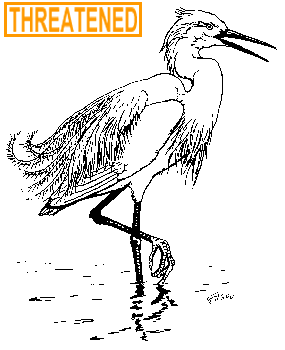Snowy Egret
Egretta thula

Habitat: Marshes, swamps, ponds, lakes, shallow coastal areas and tidal flats; occasionally found in dry fields.
Weight: Up to 13 ounces.
Length: 20-27 inches.
Wingspan: 41 inches.
Life Expectancy: In captivity, snowy egrets have lived over 16 years of age.
Food: Fishes, shrimp, crayfish, fiddler crabs, snakes, snails, aquatic and terrestrial insects, small lizards, young frogs and aquatic vegetation.
Status: State threatened.
Identification: The snowy egret is a medium-sized, white heron with a slender, black bill, black legs and yellow feet. The area of the upper bill, in front of the eyes, is yellow but turns red during the breeding season. Showy, recurved plumes are present on the back during the breeding season. The snowy egret is much smaller than the great egret.
Range: The snowy egret occurs from the United States and southern Canada, south through Central America, the West Indies, South America, and Argentina. In eastern North America, snowy egrets winter along the Gulf Coast and in Florida, as well as north along the Atlantic Coast to New Jersey. The breeding range in eastern North America extends along the Atlantic and Gulf Coasts from Maine to Texas, and inland along major rivers and lakes.
Reproduction: This highly colonial bird usually nests in mixed colonies with other herons. Both fresh and saltwater habitats are used as nesting areas. The flat, shallow nests are made of sticks and lined with fine twigs and rushes. They are usually built in trees or shrubs; nests built on the ground are more common in the west. The 3 to 4 greenish-blue, oval eggs are incubated by both adults. The young leave the nest in 20 to 25 days and hop about on branches near the nest before departing.
Reason for Decline: By the beginning of the twentieth century, snowy egrets had been decimated by market hunters for their beautiful breeding plumes. The plumes were considered fashionable adornment for women's hats. Because the plumes of snowy egrets were in greater demand than those of the great egret, snowy egrets were killed in larger numbers by plume hunters.
History in Connecticut: The snowy egret was once a common nester in Connecticut. Widespread killing of egrets for the millinery trade nearly caused the species to be extirpated from the state by the late 1800s. Since the establishment of protective laws, which put an end to the plume trade, the population has been recovering slowly. A substantial increase in population numbers was observed during the 1950s. Snowy egrets resumed nesting in Connecticut in 1961. Since the mid-1980s, snowy egrets have been observed using coastal areas in the state during summer, but breeding population levels still remain relatively low.
Interesting Facts: While feeding in shallow areas of ponds and marshes, snowy egrets use one foot to stir up the bottom, flushing prey into view. Snowy egrets will also hover, then drop to the water to catch prey in their bills.
Immature little blue herons and snowy egrets closely resemble one another, except that snowy egrets have yellow feet and showy plumes. In 1964, a hybrid snowy egret-little blue heron was reported in Florida.
The snowy egret has also been known as the lesser egret, little egret, little snowy, little white egret and little white heron.
Protective Legislation: Federal - Migratory Bird Treaty Act of 1918. State - Connecticut General Statutes Sec. 26-311.
What You Can Do: Encouraging the protection and conservation of the state's remaining coastal and freshwater wetlands, as well as offshore islands, will help snowy egrets as well as other wildlife. To reduce disturbance to colonial nesting birds, such as the snowy egret, avoid travel and recreation near nesting areas during the breeding season. Do not allow pets to roam freely in coastal or wetland habitats.

The production of this Endangered and Threatened Species Fact Sheet
Series is made possible by donations to the Endangered Species/Wildlife Income Tax
Checkoff Fund.
(rev. 12/99)

